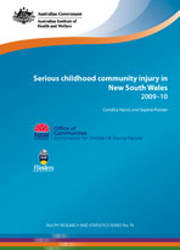Summary
This report provides summary data on hospitalised injury in New South Wales (NSW) resident children and young people (0-17) for the period 1 July 2009 to 30 June 2010. It also provides information on trends in injury between 1 July 1999 and 30 June 2010.
More than 23,000 children and young people (0-17) were hospitalised in 2009-10 as a result of an injury. Roughly equal numbers of boys and girls were hospitalised under the age of 5. There were more boys hospitalised than girls aged 5−14.
A total of 31 children died in hospital over this period as a result of injury, mainly transport- related.
The age-standardised injury rate of children and young people was just over 1,460 per 100,000 population. The rate of injury for males was 1,864 per 100,000 population and increased with age. In contrast, the rate of injury in females was 1,036 per 100,000. Similar rates were observed in the different age groups.
Causes of injury
Falls were the most commonly reported cause of hospitalised injury (39% of cases). Transport injuries were also common (14%). The most frequent cause of hospitalised falls involved playground equipment.
Age differences
Falls in the home were a frequent cause of injury for children aged 4 and under. Injury associated with burns, accidental poisoning by pharmaceuticals and drowning were also much more common in very young children. Transport injuries accounted for 20% of hospitalisations in young people aged 15-17. Pedal cycles were the most commonly reported cause of hospitalised transport injury in NSW children aged 0−14. Motorcycle rider injuries were more common in young people aged 15-17.
Sex differences
Males were more likely to be hospitalised because of transport accidents, falls and assault while females were more likely to be hospitalised for intentional self-harm injuries.
Trends over time
Significant declines in hospitalised injury since 1999 were seen in rates for poisoning by pharmaceuticals (average 6% decline per year) and poisoning by other substances (4% decline per year). Smaller but significant declines were also noted for drowning (3%), transport injuries (2%) and assault (2%).



